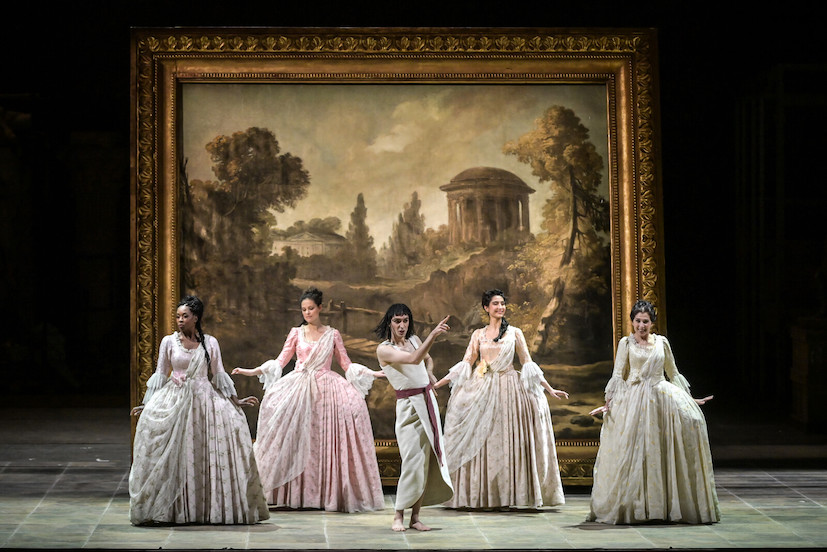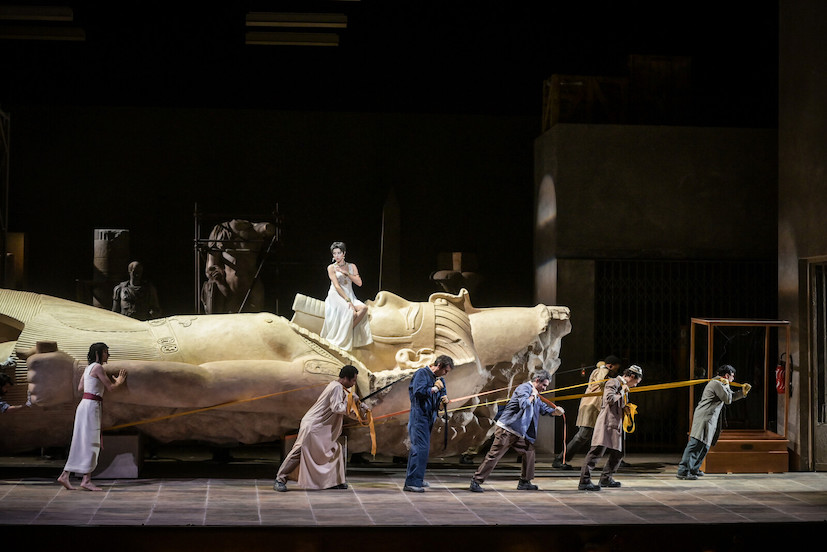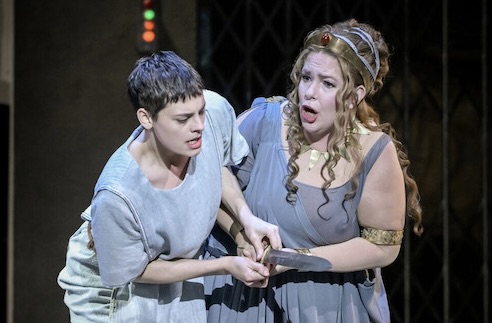This Laurent Pelly production of Handel’s Giulio Cesare is wily indeed, enriching Handel’s estimation of antiquity’s most famous female with supreme wit. Were it pure Baroque opera seria these current Parisian audiences would surely have turned to stone.
The Pelly production was first seen in 2011 with Nathalie Dessay as its Cleopatra. Just now it was Lisette Oropesa’s Cleopatra who dazzled mezzo-soprano Gaelle Arquez’s eager Caesar. (See lead photo).
In 2011 it was the Lille based Concert d’Astrée performing on Baroque period instruments, now in 2024 it was the Orchestre de l’Opéra national de Paris playing modern instruments. Thus the horns that crown the final scenes did not crack and break Handel’s gorgeous lines as did these grand, old instruments of Les Musicians du Prince in Monaco’s recent Giulio Cesare. Instead Paris’ modern horns produced the smooth musical lines that are the glory of Handel’s famed score.
British harpsichordist and conductor Harry Bicket of London’s The English Concert [music director of The Santa Fe Opera as well] pulled every subtle sigh, smile, wile, frown, groan, sob, etc., from his singers, while encouraging the same from the pairs of flutes, oboes and bassoons that joined strings (8/8/5/4/2). All together they created the seduction, desperation and triumphs of love, sorrow, despair, hate, deception and revenge that the 44 numbers of Handel’s most performed Italian opera could conjure up. There are 31 arias, 2 duets, 2 small choruses [only to begin and end the opera] plus myriad recitatives and ariosos to introduce the arias. The program booklet credits the Bärenreiter HHA edition, my count is surely close.
It is usual in performances of Handel operas that there are quite a few empty seats by the third act. Those who braved the first act and returned for the second were treated to an amazing coup de théâtre. Eight beautiful maidens in matching white, high Baroque gowns come onto the stage with instruments (including a harp) to accompany (without score) Cleopatra’s scorchingly sensual (though she is impersonating Virtue) “V’adoro pupille.” Pelly’s Parnussus scene takes place within a huge, empty painting frame surrounded by these lovely, musical muses. The frame becomes an actual Fragonard painting as it moves upstage.

The second act is Laurent Pelly’s eighteenth century act. During the act a series of paintings (of not easily perceived reference) were ferried across the stage by the warehouse hands of a major museum’s storage facility, one assumes the Louvre with its massive collections of paintings and Egyptian sculptures.
Pelly’s first act obviously takes place in the museum’s antiquities storage area. A phalanx of Roman busts mouthed the words of the opening chorus [!], eliciting the animation of the Handel’s spirits of antiquity. Cleopatra arrived atop a massive representation of an unidentifiable Egyptian deity, pulled onto the stage by warehouse hands. She was lightly draped in a white, filmy gown, covering everything, more or less, except one bare breast. The warehouse hands could not be caught looking, we were less discreet.

The third act takes place in the museum’s antique Persian rug storage area. Pelly deployed several middle-Eastern men sitting crosslegged, restoring old, worn rugs, while across the stage warehouse hands were spreading out and rolling up rugs. In this final act Cleopatra is held captive in the confines of her brother’s harem, Caesar is off in battle, the warehouse hands became the soldiers.
The Pelly sight gags are heavy handed indeed, but fly lightly because they are so very witty. This surely served to excite our sensibilities, helping us feel the powerful, dramatic crescendo of the succession of arias. Those of us who remained for the third act were tightly in the grip of a number of personal dramas — Sesto’s desire to avenge the death of his father Ptolemy; his mother Cornelia’s need to rebuff the advances of Tolomeo and Achilla; Cleopatra’s war with her brother, and her love of Caesar who she now believes to be dead.
Caesar’s ship (literally) came in. Back in the warehouse a huge statue of a Roman hero was rolled on. Caesar and Cleopatra were at last reunited and finally alone on the stage. A custodian illuminated a “ghost lamp,” the single lightbulb that darkly illuminates the ghosts of a theater’s stage.
Handel’s world was vibrantly alive with excellent performances by Lisette Oropesa’s Cleopatra and Gaële Arquez’s Giulio Cesare. Louisiana (USA) born Mlle. Oropesa is quite shapely, easily embodying the arrogant and calculating sirene of myth. As Handel’s heroine she is also a sincere lover, ready to die as her brother’s prisoner. As defeated as she was in her heartbreaking “Piangero la sorte mia,” we were smitten by its sincerity. An estimable technician of beautiful voice she wove the florid lines of her multiple arias into a convincing whole.
Though Handel created the role of Julius Caesar for the famed castrato Senesino, in this third edition of the Pelly production it was sung by French mezzo-soprano Gaële Arquez. A formidable technician of beautiful voice as well, she embodied the love-stricken Caesar with great conviction. The timbre of the female mezzo soprano voice, arriving finally at her tender “Aure, deh, per pieta spirate nel petto mio,” melded perfectly into the intense lyricism instilled by maestro Bicket.

Complementary to this lyricism were the voices and characters of German contralto Wiebke Lehmkuhl as Cornelia, wife of Pompey, and their son Sesto, sung by Canadian mezzo soprano Emily D’Angelo. Their duet, “Son nata a lagrimar” that closes Act I, was of sublime beauty.
Of note was the casting of Italian bass-baritone Luca Pisaroni as Achilla. This formidable performer well outshone his boss, Cleopatra’s brother Tolomeo (Ptolemy) performed by British counter-tenor Iestyn Davies. Nireno, Cleopatra’s trusted confidant, was sung by French counter-tenor Rémy Bres in the spirit of legendary French counter-tenor Dominique Visse, its original 2011 player.
The Pelly production (sets and costumes) was designed by Chantal Thomas and lighted by Joël Adam, both long-time Pelly collaborators. This revival was staged by Laurie Feldman.
Michael Milenski
Palais Garnier, Paris, France, February 8, 2024. All photos copyright Vincent Pontet / OnP, courtesy of the Opéra national de Paris.